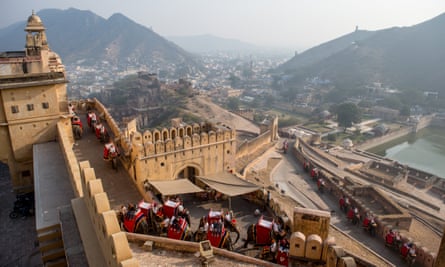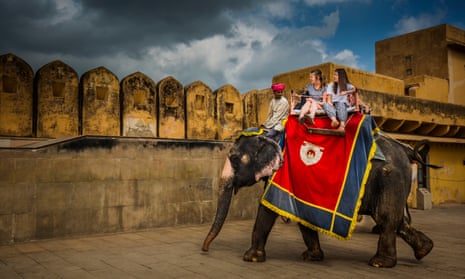Animal rights protesters took to the streets on bicycles in the Indian city of Jaipur on Sunday, demanding an end to elephants being used to carry tourists to one of the country’s top attractions, the iconic Amber Fort.
Encouraging the use of bicycles rather than burdening elephants was the aim of the protest, organised by the animal charity World Animal Protection (WAP) to mark World Elephant Day on Monday.
About 100 elephants carry tourists along the kilometre-long path up the hill to the fort. It is a steep climb on hard cobbled stones. The combined weight on the elephant’s back of two tourists, the mahout (elephant keeper) and the clunky wooden seat that holds passengers can be up to 300kg.
“It’s not just a question of the cruel methods that are used to train them in order to make them docile but also the fact that many are in dire need of medical help. The ailments range from tuberculosis, blood problems, blindness, malnourishment, and foot injuries from walking on hard surfaces,” said WAP’s Kirsty Warren.

Animal rights group in the city have been campaigning against the elephant rides for several years now and People for the Ethical Treatment of Animals (PETA) is fighting a case in the courts. But the groups have had little luck beyond persuading the tourist department to limit the number of passengers from the previous maximum of four to two, and the number of rides a day to five in winter and three in summer.
The elephant owners say they need the income maintain their livelihoods. The tourist department wants the revenue from the fort and the elephant ride is a large part of the attraction . Although jeeps are available to make the journey for those who cannot manage the tiring walk, many tourists prefer the thrill and novelty of riding an elephant.
Charities have been talking to authorities about alternatives. “We want them to promote the use of bicycles instead, not on the same steep path but on a less steep route to the fort entrance,” said Gajender K Sharma, India country director for WAP. “And we have urged them to create a sanctuary for the elephants near the fort where tourists can watch them in a natural habitat. That could become a separate tourist attraction.”
“The elephant is a wild animal even if it has been ’domesticated’. Because they are social, calm and gentle, we take advantage of their temperament and use fear and pain to make them submit. But it is a wild animal.”
Observing the elephants standing in the intense heat of an Indian summer on concrete roads, jostled by crowds and with not a tree or blade of grass in sight is an upsetting experience for Sharma. “You can the suffering in their eyes. The eyes are saying ‘this is enough, this is enough’,” he said.
